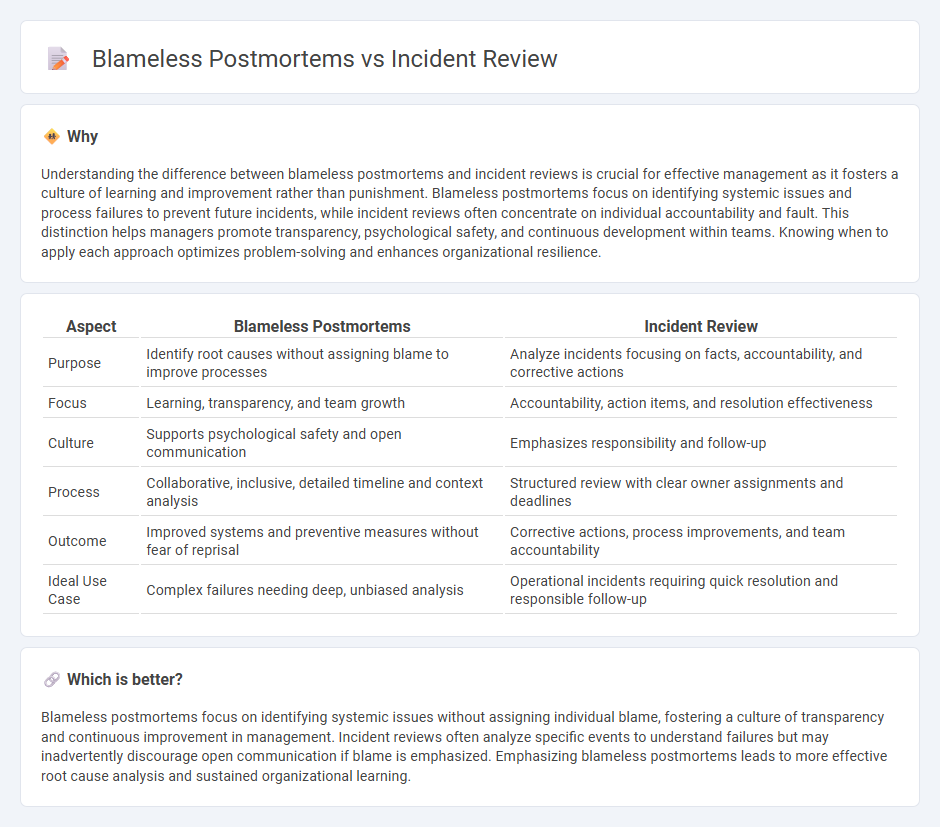
Blameless postmortems focus on identifying systemic issues and improving processes without assigning individual fault, fostering a culture of learning and continuous improvement. Incident reviews analyze the causes and effects of specific events to prevent recurrence, emphasizing accountability and actionable insights. Explore the key differences and benefits of each to enhance your organization's incident management strategy.
Why it is important
Understanding the difference between blameless postmortems and incident reviews is crucial for effective management as it fosters a culture of learning and improvement rather than punishment. Blameless postmortems focus on identifying systemic issues and process failures to prevent future incidents, while incident reviews often concentrate on individual accountability and fault. This distinction helps managers promote transparency, psychological safety, and continuous development within teams. Knowing when to apply each approach optimizes problem-solving and enhances organizational resilience.
Comparison Table
| Aspect | Blameless Postmortems | Incident Review |
|---|---|---|
| Purpose | Identify root causes without assigning blame to improve processes | Analyze incidents focusing on facts, accountability, and corrective actions |
| Focus | Learning, transparency, and team growth | Accountability, action items, and resolution effectiveness |
| Culture | Supports psychological safety and open communication | Emphasizes responsibility and follow-up |
| Process | Collaborative, inclusive, detailed timeline and context analysis | Structured review with clear owner assignments and deadlines |
| Outcome | Improved systems and preventive measures without fear of reprisal | Corrective actions, process improvements, and team accountability |
| Ideal Use Case | Complex failures needing deep, unbiased analysis | Operational incidents requiring quick resolution and responsible follow-up |
Which is better?
Blameless postmortems focus on identifying systemic issues without assigning individual blame, fostering a culture of transparency and continuous improvement in management. Incident reviews often analyze specific events to understand failures but may inadvertently discourage open communication if blame is emphasized. Emphasizing blameless postmortems leads to more effective root cause analysis and sustained organizational learning.
Connection
Blameless postmortems and incident reviews are connected through their shared focus on improving organizational learning and system reliability by analyzing failures without assigning individual blame. Both practices foster a culture of psychological safety, encouraging transparent communication and honest assessment of incidents to identify root causes and implement corrective actions. This approach enhances process optimization and reduces recurrence of issues, leading to more resilient management strategies.
Key Terms
Root Cause Analysis
Incident review emphasizes identifying accountable parties and assigning responsibility, often leading to a top-down analysis of failures. Blameless postmortems prioritize a culture of transparency and learning by focusing on root cause analysis without attributing fault, fostering continuous improvement and trust within teams. Discover effective strategies to implement root cause analysis through blameless postmortems for enhanced incident management.
Accountability
Incident reviews emphasize identifying individual accountability to prevent future errors, often attributing responsibility to specific team members. Blameless postmortems prioritize learning from failures by fostering a culture of psychological safety, encouraging open discussion without fear of punishment. Explore the benefits of adopting blameless postmortems to enhance team collaboration and continuous improvement.
Continuous Improvement
Incident reviews emphasize identifying errors and assigning responsibility to prevent recurrence. Blameless postmortems prioritize understanding systemic failures by fostering a culture of psychological safety and learning from incidents without punishing individuals. Explore deeper insights into how blameless postmortems drive continuous improvement in organizations.
Source and External Links
Incident Review - Sample Written Program - This document outlines procedures for conducting an incident review to determine the cause of an incident and identify possible causes such as personal factors, unsafe conditions, and unsafe acts.
A Guide to Post-Incident Review - This guide emphasizes the importance of post-incident reviews in security to understand the root cause of an incident and identify vulnerabilities to prevent similar attacks in the future.
How To Conduct Incident Reviews & Postmortems - This article discusses best practices for conducting incident reviews in IT and business, focusing on structured analysis to improve service quality and prevent future disruptions.
 dowidth.com
dowidth.com